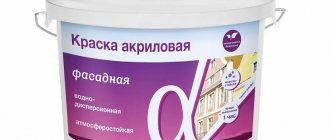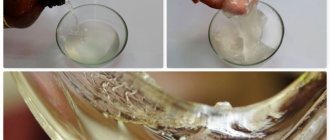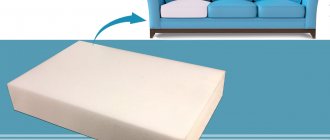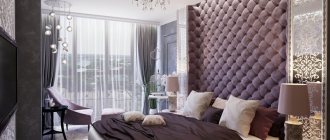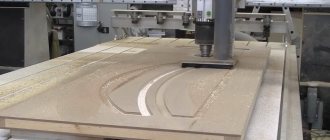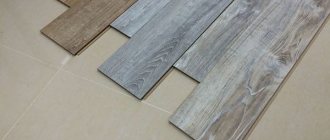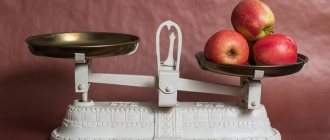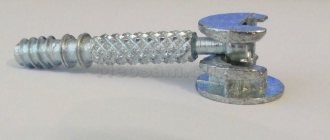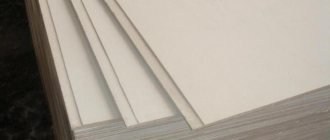What kind of material is this? Decoding the abbreviation
MDF is an abbreviation that comes from the English language. Literally translated, the name of the material sounds like MEDIUM DENSITY FIBERBOARD. The first letters of these words served as the basis for the creation of a familiar colloquial term. Translated into Russian, the name of the material stands for medium-density fiberboard.
Composition and Characteristics
In terms of its structure, MDF is a wood fiber board consisting of crushed sawdust. During the manufacturing process, the raw materials are cleared of sawdust and converted into a powder state. Then the resulting composition is treated with steam and an adhesive base is added: lignin and paraffin.
Among the main advantages of MDF are the following characteristics:
- Resistance to dynamic loads. To break an MDF panel, a force of 15 MPa must be applied. According to mechanical properties. The material is significantly superior to solid wood.
- Environmental Safety. The release of formaldehyde from the panels must meet the requirements:
Test method Release rate into air Purpose of tests Chamber method according to GOST 30255-95 no more than 0.124 mg/m3 air Qualification and control periodic tests Gas analysis method according to GOST 53867-2010 no more than 3.5 mg/m2 per hour Production control - Reliability. The material has increased moisture resistance, is absolutely neutral to temperature changes and direct sunlight.
- Easy to process. With high strength, MDF is easy to process; if desired, you can decorate the panel with decorative cuttings.
- Density. MDF from 600 to 850 kg/cub.m. Fiberboard is also produced in low density (LDF) from 200 to 600 kg/m3 and high density (HDF) over 800 kg/m3 .
It is worth noting that fungus and mold do not appear on the slabs.
What is MDF made from?
Wall panels, known by the abbreviation MDF, are made from wood chips by pressing dry fibrous raw materials at elevated pressure and temperature using special non-toxic resins. The products have average density, which is reflected in the abbreviation, which is the English tracing paper for the name of the material - medium-density fiber board.
Wood wall panels, called MDF, have gained consumer recognition as a material for finishing both office and home spaces, including living rooms, hallways, kitchens, bedrooms and other living and utility spaces. The products can be used to cover any structures, walls, ceilings, furniture, and decorative interior elements.
MDF or PVC: which is better?
It’s worth clarifying right away that two finishing materials (MDF and PVC) are widely used in home construction and have no complaints about quality. Therefore, when choosing, you need to focus on the area of application. For example: MDF is considered more environmentally friendly, so it will be suitable for decorating a nursery or living room without any problems. PVC is impervious to any aggressive influences, so it is often used to decorate bathrooms and kitchens.
It is worth noting that PVC has minimal weight, so when installing it is quite possible to do it yourself. However, this material is very susceptible to mechanical damage, so even a slight blow can damage the surface. MDF is more resistant to external influences, but it cannot remain in a humid environment for a long time.
Exterior design
The design options for the outer layer differ significantly. The choice of the buyer largely depends on its type.
Veneering and laminating
Veneered MDF panels, which are most often used for wall decoration, have a look that imitates natural wood. On the outside of such a fiber board, a thin layer of wood is actually fixed, which is usually called veneer. The impressive appearance is pleasantly complemented by a more affordable price compared to natural wood.
Note! There are wall products covered (laminated) with a layer of paper. Such panels are quite inexpensive, but they lose their beautiful appearance quite quickly.
Lamination
Laminated MDF panels have a high-gloss surface, painted white or any other color. For single-sided slabs, the polymer film covers only the front part. The reverse surface, which turns out to be directed towards the wall during installation, does not have synthetic protection.
Double-sided boards have the advantage that both surfaces are coated with polymer. This allows the material to be used for installing partitions when remodeling space.
Designers are interested in models designed to look like natural oak, beech, woven linen, and also those with colored paint.
Products with a reinforced laminate layer are used as moisture-resistant MDF panels for finishing rooms with high humidity, such as the bathroom or the area near the kitchen sink. Typically, the polymer film is of acrylic or polyvinyl chloride nature and is characterized by complete water resistance when the edge is properly and hermetically joined, treated with special compounds, which was not initially covered with protection.
Textures, drawings, colors
On some types of MDF wall panels, drawings are made, pictures are printed with photographs, and painted in glossy and matte colors. Such products allow designers to bring any creative ideas into reality, making the premises original and unique.
Wall panels with a polished surface can be finished by subsequent milling and used for decorative interior decoration.
Embossed MDF is in demand, creating a three-dimensional 3D effect. They are used to decorate walls and ceilings, creating an unusual modern interior.
Types of wood-fibrous material
There are many varieties of MDF on the domestic market, so problems with choosing a finishing option usually do not arise. The assortment of construction stores usually includes the following categories:
- Laminated . A special film is applied to the surface, which gives standard panels different shades. The surface can be matte or glossy.
- Veneered . This is quite expensive material. Here, veneer made from valuable wood species is glued to both sides of the panel.
- For painting . This is a special type of MDF designed for self-painting. The surface is coated with a special compound that ensures adhesion to dyes.
- Wall panels . Such products are very convenient in terms of installation for interior decoration. A “groove-lock” fastening system is used here, which ensures reliable adhesion of the elements to each other. It is worth noting that the wall panels are attached with a stapler or glue.
- Moisture resistant . This material is impregnated with a special composition, so it can remain in high humidity conditions for a long time. In their properties, such panels are very similar to PVC.
- Flexible . The material is resistant to dynamic loads, so it can bend without receiving mechanical damage. Typically, such panels are used when decorating arches.
MDF boards are used to make interior doors, decorative kitchen splashbacks and cabinet furniture facades. External parameters depend on the type of application.
MDF finishing panels
Finely dispersed pressed boards serve as the basis for the production of decorative finishing panels. The front surface is covered with paper. This is the cheapest option. Slightly more expensive ones are laminated with PVC film. There are also panels covered with veneer. This is a more expensive material. There are also options with plastic, but very rarely.
MDF panel with three-dimensional image - 3D
Decorative MDF panels are most often used to cover walls and sometimes ceilings. This finishing method saves time: the surface is leveled and immediately takes on its final form, since no additional finishing is required.
Types of decorative MDF panels
We will not talk about colors and shades, but about the shape of the inlet and the type of decorative surface. The shapes of finishing panels made of pressed wood fibers are:
- Rack type. The length is many times greater than the width. Length 2.0 m - 3.0 m, width from 150 mm to 250 mm. When choosing, pay attention to the thickness of the panel (from 3 mm to 9 mm) and the depth of the lock. Ideally, the lock (protrusion) should be at least 5 mm. In this case, joining the planks will be easy and problem-free. Mounted on a frame, secured into a tongue or groove using self-tapping screws.
Linear type MDF panels
- Tiled type. Rectangular or square slabs. The maximum dimensions are meter by meter, but rectangles with different aspect ratios are more common. They are mounted on a frame or directly to the walls using a special system of hidden fasteners, the fragments of which “cling” to the protrusions of the slabs.
Tiled type - in the form of rectangles of different sizes
- Sheet panels. They are rarely used for interior decoration, more often - for cutting in the manufacture of furniture. But, if necessary or desired, they can also be used as finishing, installing fasteners more often.
When choosing MDF panels, pay attention to the type of finish. The cheapest material is covered with paper, on top of which a thin layer of protective coating is applied. It is clear that such a surface gets scratched quickly; it can only be wiped with an exceptionally soft, slightly damp cloth. You cannot even use a rough sponge, otherwise light spots will form. Such MDF panels are good for finishing the ceiling - there is no mechanical load at all. If you install them on walls, it is better to immediately cover them with two layers of varnish. You choose the type of surface yourself - gloss, semi-gloss, matte, semi-matte... It is important that the film is durable.
These are several more types of 3D MDF wall panels
More expensive ones - with PVC and veneer - do not require additional finishing, but the price is 2-3 times more expensive. If your budget is limited, the option described above is not bad.
Installation methods
MDF panels are mounted either on the frame or directly on the wall using glue. The technology is described in the previous paragraph and differs only in that clamps are used for installation - special fastening plates for hidden mounting. The first panel on the wall is installed in the corner. Here it is attached through and through using self-tapping screws. All others are fixed with clamps. After installation is completed, the corners are closed with a special corner profile. It is mounted with glue - applied in a thin layer and pressed at the installation site.
There is also a system of profiles - starting, finishing, connecting and corner (outer and inner corners). But this fastening system is more expensive; it is used with veneered MDF panels, square or rectangular.
There is another subtlety of installing decorative MDF panels on the ceiling. If you use thin sheets/planks - 3-4 mm thick - you need to install hangers often, otherwise the material will bend under its own weight. When using slabs 6-8 mm thick, hangers can be installed less often. They are more rigid and do not bend. But the weight of the finish will be greater, so you will have to use more powerful guides and the hangers themselves.
Dimensions of material
Depending on the area of application of MDF, the dimensions of the facing material also change. Here you can derive the following standards:
- Wall panels. The standard length of the wall panel is 2.62 meters, however, some manufacturers produce products with lengths 2.44 and 2.8 m. Width may vary within 100-900 mm. Panels are divided into types depending on width P-1, P-2, P-3, P-4, P-5 (100, 125, 150, 175, 250). With panel thickness 3-30 mm. The thickness of veneered MDF can reach 60 mm.
Compliance with quality requirements:Specific resistance during normal coating separation. MPa, not less 0,4 Coating abrasion resistance, rpm, not less 30 Hardness of protective and decorative coating, microns. no more 120 Warping, µm/m, no more 1.5 - Plates . The length of the material is usually about 1.5 meters , width - 100-900 mm . The thickness of MDF boards varies between 6-24 mm .
- Facades . Considering the various options and dimensions of furniture, there are no strictly defined standards. The following parameters can be considered as a basis: thickness 16 mm , height 140-934 and width 296-596 mm .
- Aprons . For the manufacture of decorative aprons, furniture panels are usually used, which have the following characteristics: length - 3,000 , width - 600 and thickness 6-10 mm .
- Countertops . This element must be resistant to dynamic loads, so the following dimensions are used here: length - 1,000 , width - 600 and thickness 28-38 mm .
- Doors . MDF doors are usually made according to the following standard: thickness - 35-45 mm , height - 190-200 cm , width - 70-90 cm . Read more about door and opening dimensions >>>
It is worth noting that the dimensions given may vary depending on the manufacturer.
Table of parameters of polished sheets.
| Manufacturer country | Dimensions (mm) | Sheet thickness (mm) | Density (kg/m³) | Sheet weight (kg) |
| Russia | 2440×2050 | 3 | 840 | 13 |
| Russia | 2440×1830 | 3 | 840 | 12 |
| Ukraine | 2800×2070 | 3 | 780 | 15 |
| Russia | 2800×2070 | 6 | 750 | 26 |
| Ukraine | 2800×2070 | 6 | 780 | 27 |
| Germany | 2620×2070 | 6 | 800 | 26 |
| Russia | 2800×2070 | 8 | 750 | 35 |
| Ukraine | 2800×2070 | 8 | 780 | 36 |
| Germany | 2620×2070 | 8 | 800 | 35 |
| Russia | 2440×1830 | 10 | 800 | 36 |
| Russia | 2800×2070 | 10 | 750 | 43 |
| Ukraine | 2800×2070 | 10 | 770 | 45 |
| Germany | 2620×2070 | 10 | 790 | 43 |
| Russia | 2800×2070 | 12 | 750 | 52 |
| Ukraine | 2800×2070 | 12 | 770 | 54 |
| Germany | 2620×2070 | 12 | 790 | 51 |
| Russia | 2440×1830 | 16 | 800 | 57 |
| Russia | 2800×2070 | 16 | 750 | 70 |
| Ukraine | 2800×2070 | 16 | 770 | 71 |
| Germany | 2620×2070 | 16 | 790 | 69 |
| Russia | 2440×1830 | 18 | 800 | 64 |
| Russia | 2800×2070 | 18 | 730 | 76 |
| Ukraine | 2800×2070 | 18 | 750 | 78 |
| Germany | 2620×2070 | 18 | 770 | 75 |
| Russia | 2800×2070 | 19 | 730 | 80 |
| Ukraine | 2800×2070 | 19 | 750 | 83 |
| Germany | 2620×2070 | 19 | 770 | 79 |
| Russia | 2800×2070 | 22 | 730 | 93 |
| Ukraine | 2800×2070 | 22 | 750 | 96 |
| Germany | 2620×2070 | 22 | 770 | 92 |
| Russia | 2440×1830 | 24 | 800 | 86 |
| Russia | 2800×2070 | 25 | 730 | 106 |
| Ukraine | 2800×2070 | 25 | 750 | 109 |
| Germany | 2620×2070 | 25 | 770 | 104 |
| Russia | 2800×2070 | 28 | 720 | 117 |
| Ukraine | 2800×2070 | 28 | 740 | 120 |
| Germany | 2620×2070 | 28 | 750 | 114 |
| Russia | 2800×2070 | 30 | 720 | 125 |
| Ukraine | 2800×2070 | 30 | 740 | 129 |
| Germany | 2620×2070 | 30 | 750 | 122 |
| Germany | 2620×2070 | 38 | 750 | 155 |
| Germany | 2620×2070 | 40 | 750 | 163 |
| Germany | 2800×2070 | 40 | 740 | 172 |
Table of parameters of laminated sheets.
| Manufacturer country | Dimensions (mm) | Thickness (mm) | Number of laminated sides | Weight, kg) |
| Russia Ukraine | 2800×2070 | 16 | 1 | 74 |
| Russia Ukraine | 2800×2070 | 16 | 2 | 74 |
| Russia Ukraine | 2800×2070 | 19 | 1 | 88 |
| Russia Ukraine | 2800×2070 | 19 | 2 | 88 |
| Germany | 2620×2070 | 10 | 1 | 43 |
| 2620×2070 | 16 | 1 | 69 | |
| 2620×2070 | 18 | 1 | 78 | |
| 2620×2070 | 19 | 1 | 82 | |
| 2620×2070 | 22 | 1 | 95 |
Table of parameters of sheets laminated with paper film.
| Dimensions (mm) | Thickness (mm) | Weight, kg) |
| 3 | 2440×1830 | 11 |
| 4 | 2440×1830 | 14 |
| 6 | 2440×1830 | 21 |
| 6 | 2800×1830 | 25 |
| 8 | 2800×1830 | 33 |
| 10 | 2440×1830 | 36 |
| 10 | 2800×1830 | 41 |
| 12 | 2800×1830 | 49 |
| 16 | 2440×1830 | 57 |
| 16 | 2800×1830 | 66 |
| 18 | 2440×1830 | 64 |
| 18 | 2800×1830 | 74 |
| 19 | 2800×1830 | 78 |
| 22 | 2800×1830 | 90 |
| 24 | 2440×1830 | 86 |
| 25 | 2800×1830 | 102 |
Wall slabs
The use of MDF for wall decoration is justified by a number of positive qualities of this material. They allow you to level the surface without the use of dry mixtures, which saves apartment owners from lengthy, dirty repairs that consume a lot of time and money.
How to use brick-like decorative panels for interior decoration can be found in this article.
The installation of the slabs is carried out using special aluminum profiles attached to the walls parallel to the floor. However, this method “eats” about 5 cm of living space on each side of the room, so if the condition of the walls allows it, you can use the adhesive method of fastening. For this purpose, a certain type of glue is used, which, even after hardening, retains its plastic qualities, which prevents deformation and shrinkage of the slabs. In addition, the structure of the glue must be thick enough to fill uneven walls of varying depths.
PVC panels for the kitchen, photos with drawings and other technical data about the building material can be found and seen from this article.
Dimensions and installation for MDF video wall panels:
The advantage of MDF panels compared to wallpaper that is more familiar to most consumers is the following positive qualities:
- moisture resistance : particle boards are not so afraid of high humidity in the room, which is typical for apartments during the rainy demi-season period;
- easy installation : the lathing only needs to be done once, for the initial installation; If the owners want to change the design of the room, then it is enough to dismantle the old panels and install new ones in their place. This will take an order of magnitude less time than the “dancing with a tambourine” that usually accompanies wallpapering;
- fast and affordable room cleaning : it’s no secret that even on vertical surfaces a huge amount of dust accumulates. The good thing about MDF material is that it allows for wet cleaning - this is a definite plus for people prone to respiratory allergic reactions;
- additional soundproofing of the room;
- the ability to place computer and electrical cables behind the panels;
- environmental friendliness : MDF contains much less toxic substances than chipboard and some types of wallpaper (vinyl, non-woven).
MDF material, what it is and what a building material is, can be found out in this article.
The MDF panel has a groove on one side and a special latch on the other, allowing them to be connected like a lock into a continuous surface with barely noticeable seams.
Leroy Merlin PVC panels for the bathroom will fit perfectly into the interior of the room, which you can find out in more detail in this article.
The disadvantages of the material include the fact that psychologically it becomes obsolete faster than it wears out. In this regard, they are more often used for cladding non-residential premises that are not so often seen - corridors, loggias, bathrooms, kitchens, as well as offices. A plastic corner is used as a “plug” masking the end of the decorative part, the length of which ranges from 1300 to 3600 mm, and the width of the strips is about 56 mm. The size of the HDF sheet also varies within these limits. The color of the corner is selected to match the color of the panel in such a way as to fully match it, but if the design idea requires it, it can, on the contrary, contrast with the general background.
What is the standard type and size
According to their appearance and parameters, wall panels are classified into slats, tiles and sheets. The first resemble long narrow slats, which, after installation is completed, resemble wooden boards attached to the walls, painted in different colors.
You can see what wall panels for a bathroom in Leroy Merlin look like in this article.
The texture of the second is similar to tiles laid in even rows, while the third is sheets with a smooth surface. They have the same technical characteristics, but the difference in shape allows you to visually expand or narrow the room, emphasize the texture of the walls or, conversely, make them inconspicuous. What should the dimensions be? The size of the panels may also depend on the manufacturer.
| Manufacturer | Size, mm | Thickness, mm |
| Kronospan | 2600×200 | 7 or 14 |
| 2600×325 | 9 | |
| 2600×153 | 7 or 8 | |
| HDM | 1300×158 | 6 |
| 2600×198 | 6 | |
| Union | 2600×238 | 7 |
| ProfiLine | 2600×238 | 7 |
| Grenagloss | 2750×1300 | 17 |
| 2800×1300 | 10 | |
| 2440×1220 | 19 | |
| Eco Forest | 2800×2070 | 3, 5, 6, 8, 10, 12, 16, 18, 19, 22, 25, 28, 30, 38. |
When choosing the appropriate size, you should take into account the total area of the room and the pattern of the panel: it should end harmoniously at the floor and ceiling and not cause a feeling of raggedness.
MDF weight
The external dimensions and thickness of the panel play a key role. Weight according to dimensions is given in the tables above. Let's see how the weight of an MDF panel measuring 2,800*2,050 mm (the maximum value on the market) will change, depending on the thickness of the product:
- 3 mm – 16 kg.
- 6 mm – 31 kg.
- 12 mm – 60 kg.
- 22 mm – 106 kg.
- 28 mm – 142 kg.
It is worth noting that the weight of the decorated panels will vary slightly upward.
Standard sizes of MDF panels - Homework
The dimensions of MDF material differ significantly, which allows you to choose the best option for installation on various surfaces (walls, ceilings). Such panels are superior in strength to the well-known counterpart of chipboard, and in addition to this, they also do not contain harmful substances.
More information about the material
MDF is based on wood waste (shavings, sawdust). The raw materials are crushed, dried and processed under high temperatures. The result is a homogeneous mass, and paraffin and lingin act as a binding agent.
The last of these is a product of heating wood dust. To give the material the external characteristics of wood, cut wall panels are covered with melamine film. They are also painted.
Main dimensions of the material
There are standard and non-standard sizes of MDF sheets. Some manufacturers offer a product line that is different in size, which allows you to implement unusual projects.
Length values
The standard size is 2.6 m. Less common material is 2.4 m long, as well as 2.7 m long. In addition to such sheets, at the customer’s request, they are produced with a length from 900 to 3660 m. Lath and typesetting material are presented as a separate category. The first option is characterized by a length of 2 to 4 m. These are boards of small width and thickness.
MDF panels are made in the shape of a square and are characterized by small dimensions - from 29 to 95 cm on one side. This material is suitable for walls, since you can assemble a certain pattern from individual slabs.
Width
The value of this parameter can vary greatly: from 0.15 to 2.07 m. More often found for walls in formats up to 0.9 m. If we consider typesetting material, then the dimensions in this case will be different, in particular, the width varies within 0 ,11 to 0.29 m. It is recommended to choose one with a coating that matches the structure of the wood. Such a solution will create the appearance of finishing with natural material.
Wide panels can be placed horizontally, it will look original and expand the room
Large format MDF sheets are recommended to be used with the texture of natural stone.
Another option when it is better to use a material of large width is a tile finish.
In this case, a minimum number of connecting seams between the slabs will ensure the natural appearance of the wall covering.
Standard material sizes from popular brands
KRONOSPAN products are known not only for their quality, but also for providing a wide range of panels, different in size and shade.
Exact sizes by country of manufacture
Standard sizes of sheets of this brand:
- The 7 mm thick product is offered in two variations: 2.6x0.153 m and 2.6x0.2 m;
- 2.6x0.153 m with a thickness of 8 mm;
- 2.6x0.325 m thickness 9 mm;
- 2.6x0.2 m thickness 14 mm;
- 2.8x2.07 m with a thickness from 6 to 28 mm;
- 2.62x2.07 m with a thickness from 6 to 28 mm.
Different types (laminated, veneered) are characterized by different sizes. HDM brand products offer wall material in formats of 2.6x0.198 m and 1.3x0.198 m (thickness 6 mm).
A distinctive feature of such products is their moisture-resistant qualities, which allows them to be used when finishing rooms with high humidity levels (bathroom, swimming pool, etc.). And Soyuz brand products are presented in one version - 2.6 x 0.238 m with a thickness of 6 mm. But at the same time, the range of panels is expanded by adding shades.
In addition, the variety of designs simplifies the production process, since different quantities of raw materials can be sold, which, in turn, reduces the amount of waste.
If you choose products of large thickness, this will provide additional sound insulation of the room. But installing large panels usually leads to a significant reduction in free space.
(31,33
Source: https://homeandworks.ru/standartnye-razmery-mdf-panelej.html
Standard panel colors. Texture
Thanks to modern technologies, you can choose the shade of MDF panels to suit any interior design. In particular, on the market there are textures like stone, natural wood, imitation metal surfaces, copper, silver and mother-of-pearl.
However, the most recognized are the standard MDF colors that imitate solid wood. Here you can select the following colors:
- Apple tree
- Nut
- Ash
- Cedar
- Bleached oak
- Cherry
- Ash
Such panels accurately imitate wood and are suitable for finishing any interior space.
How to paint MDF
If necessary, you can refresh your boring interior by repainting the surface in a different color. It is worth clarifying that the procedure is quite complicated, but quite doable on your own. Here are the following stages:
- Prepare the dye. The best option for painting MDF would be to mix paint and hardener in a ratio of 1:9, respectively. To prevent the composition from hardening, regular stirring is required.
- The basis. The panels must be sanded and primed. The thickness of the primer layer should vary between 100-140 microns. The primer usually dries within 2-6 hours.
- Painting. At this stage, several layers of paint are applied, each thickness is about 80 microns. The finishing layer can be polished to give the surface a glossy finish.
- Drying. For the dye to “adhere”, it is necessary to keep the painted panel for 8-12 hours at room temperature.
If we talk about paint, then the following emulsions are suitable for MDF:
- Alkyd or oil based.
- Contains polyurethane resins.
- Nitro paint of NC category.
- Aerosols on acrylic base.
In addition, special enamels for painting MDF are sold.
Accessories. Clamps for fastening panels
What is a gluer for MDF? Essentially, it is a small metal plate that is used during the installation process. The clamps are inserted into special grooves and screwed to the sheathing with self-tapping screws. The result is a reliable mount that remains hidden after installation work is completed.
The clamps are marked with numerical indices from 1 to 6. The marking is deciphered as follows: this is the distance from the base of the part to the locking tongue in millimeters. When installing wall panels, clamps with the index “2” are used, however, everything depends on the specific thickness of the material.
